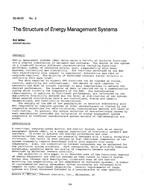Description
Energy management systems (EMS) which serve a variety of building functions are a complex combination of hardware and software. The design of the system is a trade-off between different characteristics including functions performed, number of connected points, cost, compatibility with other systems, reliability and flexibility. The functions performed by the EMS vary significantly with respect to complexity, interaction and rate of response required. The majority of functions interact either directly or indirectly with each other.
The data required to support EMS functions can be classed as status, control, qualifying and informational. The amount of data required is extensive and must be brought together in many combinations to achieve the desired performance. The transfer of data is carried out by a communication system which connects the components of the EMS. The communication requirements, in addition to functional performance, are influenced by the application flexibility desired and the level of distribution of the system. Three general distribution levels are centralized, status and control decentralized, and functionally decentralized.
The ability of the EMS of one manufacturer to interact effectively with EMS components or complete systems of other manufacturers is limited by the respective selections for data structures, communication methods and level of distribution. In general, the unique selection of characteristics chosen by each manufacturer precludes the integration of energy management system components of different manufacturers unless details of implementation are known.
Product Details
- Published:
- 1983
- Number of Pages:
- 10
- File Size:
- 1 file , 910 KB
- Product Code(s):
- D-DC-83-05-2
- Note:
- This product is unavailable in Russia, Belarus




